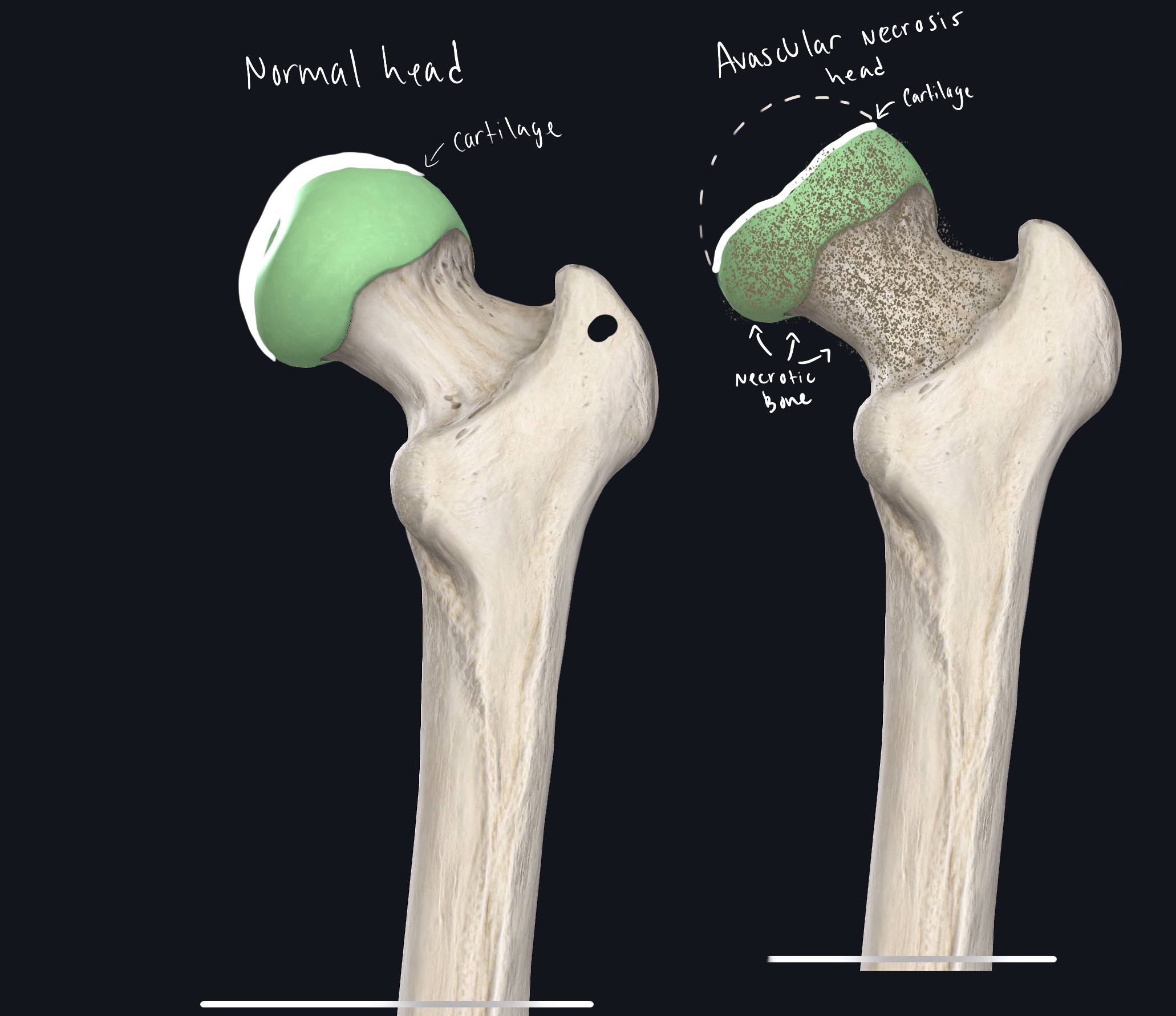Osteonecrosis, also known as avascular necrosis (AVN), aseptic necrosis or ischemic bone necrosis is a disease that can result in the death of bone cells. There are subsequent structural changes that lead to the femoral head collapse, secondary hip joint osteoarthritis which finally results in hip dysfunction. AVN is also known as Chandler’s disease or osteochondritis of the femoral head.
Avascular Necrosis can happen to any bone; however, it is typically found at the end of long bones (epiphysis) such as the femur. The acetabulum is one of the more commonly affected locations. This Osteonecrosis is due to a disruption of blood supply that can be caused by multiple reasons such as traumatic or atraumatic. This includes dislocations, chronic opioid/alcohol abuse, congenital causes and fractures, among many others. Aggressive treatment is recommended to slow down the disease but ultimately surgical intervention is required for most patients with AVN.
The important and the majority blood supply of the femoral neck is located on the postero-superior aspect of the femoral neck. The main blood supply for the weight bearing dome of the femoral head is the medial femoral circumflex artery (lateral epiphyseal artery). The Acetabulum’s blood supply comes from the acetabular branch of the obturator artery and branches from the superior gluteal artery. Due to the limited collateral circulation, if blood is disrupted to the head of the femur, it can lead to ischemia followed by necrosis. And of course, if the blood supply is not restored in time, it will cause a domino effect, starting with the death of the osteocytes, following with the collapse of the articular surface, and eventually by degenerative arthritis. Traumatic causes for AVN are typically a femoral neck fracture or a displacement fracture of the femoral head from the acetabulum.
The disease progresses through four stages.
- Initial necrosis – Blood Supply gets disrupted, and the necrosis begins.
- Fragmentation – the body starts to absorb the necrotic bone and attempts to replace it with weak bone that is prone to breaking and collapse.
- Re-Ossification – stronger bone develops
- Healing- bone regrowth is complete, the shape of the bone finishes (could vary depending on the extent of the damage done through fragmentation phase)
AVN can be asymptomatic early on in the disease process, however when they become symptomatic, the first sign is usually a hip pain located in the thigh or groin area. This pain is then exacerbated by activities that require range of motion. Unfortunately, this applies to major axis that allow motion such as the transverse axis, sagittal axis, ect.
Case studies have also been shown to damage the sympathetic nerve fibers.. This is due to the AVN that is proceeded by an inflammatory reaction which leads to arthritic changes in the tissues. This in turn can lower the number of sympathetic nerve fibers and within the immediate environment of an inflammatory process, sensory nerve fibers/ sympathetic nervous system is stimulated, by the hypothalamus-pituitary axis. This increases the adrenaline, endogenous cortisol, and adenosine with inflammatory reactions. IF the inflammation continues over a long period, like rheumatoid arthritis for example, the body becomes adapt. This adaption causes the hypothalamus and the pituitary to remain dormant.
In summary, this degenerative disease targets multiple organ systems that are not limited only to the skeletal system, but transverses to the endocrine, muscle, vascular and nervous systems as well.
Ozkunt O;Sarıyılmaz K;Sungur M;Ilen F;Dikici F; (n.d.). Bilateral avascular necrosis of the femoral head due to the use of heroin: A case report. International journal of surgery case reports. Retrieved November 23, 2021,
Claffey TJ. Avascular necrosis of the femoral head. An anatomical study. J Bone Joint Surg Br. 1960;42-B:802–809.
Loss of sympathetic nerve fibers in vital intertrochanteric bone cylinders lateral to osteonecrosis of the femoral head. (2012). Pubmed.Ncbi. https://pubmed.ncbi.nlm.nih.gov/22575068/


This reading is very informative on osteonecrosis of the femoral head. This is also known as avascular necrosis (AVN), this is a disease that can result in the death of bone cells. AVN is also known as Chandler’s disease or osteochondritis of the femoral head. With AVN it can happen to any bone, but it is more commonly found at the end of long bones. This disease is affected by the disruption of blood supply. The lack of blood supply it can be caused by a traumatic or atraumatic situation.
With this disease, it progresses through four stages, the first stage is initial necrosis which is the blood get disrupted, second fragmentation- where the body absorbs the necrotic bone, third Re-Ossification which develops stronger bones and the last step is the healing which is where the bone growth is complete.
With studies, sympathetic nerve fibers have been damaged by AVN due to the inflammatory reaction which leads to changes in the tissue. If the inflammation continues long term it can lead to the body adapting which adaptation can lead to the hypothalamus and the pituitary remaining dormant.
Ozkunt O;Sarıyılmaz K;Sungur M;Ilen F;Dikici F; (n.d.). Bilateral avascular necrosis of the
femoral head due to the use of heroin: A case report. International journal of surgery case
reports. Retrieved November 23, 2021,
Claffey TJ. Avascular necrosis of the femoral head. An anatomical study. J Bone Joint Surg Br.
1960;42-B:802–809.
Loss of sympathetic nerve fibers in vital intertrochanteric bone cylinders lateral to osteonecrosis
of the femoral head. (2012). Pubmed.Ncbi. https://pubmed.ncbi.nlm.nih.gov/22575068/